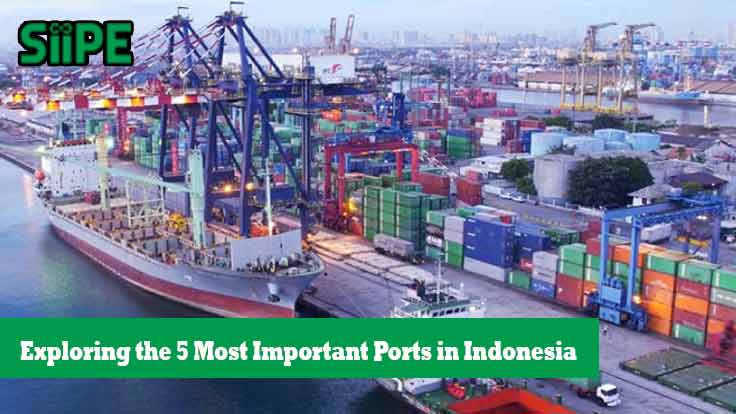1. Port of Tanjung Priok (Jakarta)
Tanjung Priok is the largest and busiest port in Indonesia, located in North Jakarta. Serving as the primary gateway for goods entering and leaving the country, it handles about 40% of Indonesia’s total cargo. Tanjung Priok is a critical hub for both international trade and domestic distribution, making it the backbone of Indonesia’s trade network.
Significance:
- Main Trade Gateway: Tanjung Priok is the heart of Indonesia’s import and export activity, handling a wide variety of goods, from consumer products to raw materials like oil and coal. The port is a vital link between Indonesia and major global trade partners, including China, the United States, and Japan.
- Modern Infrastructure: Over the years, Tanjung Priok has undergone substantial upgrades, including the development of high-tech container terminals and logistics systems that improve the speed and efficiency of cargo handling.
- Strategic Location: As the gateway to the capital city, Jakarta, Tanjung Priok plays a significant role in ensuring the smooth flow of goods into the nation’s economic heart.
2. Port of Surabaya (Tanjung Perak)
Located in Surabaya, East Java, Tanjung Perak is Indonesia’s second-largest port. Serving the major commercial center of Surabaya and the surrounding region, Tanjung Perak handles a wide range of cargo, from bulk goods to containerized freight. The port is vital for trade between Indonesia and its neighbors, particularly Southeast Asia.
Significance:
- Regional Hub: Tanjung Perak is a key hub for East Java, supporting the flow of goods between Surabaya and other parts of Indonesia, as well as international trade. Its location along the northern coast of Java makes it a significant point for shipping between Indonesia and the Asia-Pacific region.
- Industrial Importance: Surabaya is one of Indonesia’s major industrial cities, and Tanjung Perak supports the distribution of industrial goods, raw materials, and machinery needed by the local manufacturing sector.
- Port Development: In order to meet the growing demand for cargo handling, the port is undergoing an expansion to increase its capacity and improve services, particularly in container handling and logistics.
3. Port of Makassar (Soekarno-Hatta Port)
Makassar, located on the island of Sulawesi, is home to the Soekarno-Hatta Port, which serves as the primary port for Eastern Indonesia. The port is a vital transportation hub for both goods and passengers, linking the region to other parts of Indonesia and beyond.
Significance:
- Gateway to Eastern Indonesia: Soekarno-Hatta Port plays a critical role in facilitating the movement of goods to and from Indonesia’s eastern regions, particularly raw materials like coal, palm oil, and agricultural products.
- Support for Local Industries: The port is essential for supporting industries in Sulawesi, such as mining, agriculture, and fisheries. These sectors depend on the port for shipping goods to both domestic and international markets.
- Tourism and Ferry Services: In addition to freight, the port also provides ferry services that connect Makassar with neighboring islands, making it a crucial point for tourism and passenger transport.
4. Port of Belawan (Medan)
Belawan Port, located in Medan, North Sumatra, is one of the major ports in Indonesia’s western region. It serves as the key shipping hub for goods from Sumatra, particularly agricultural products like palm oil, rubber, and cocoa, which are critical exports for Indonesia.
Significance:
- Agricultural Export Hub: Sumatra is known for its agricultural output, and Belawan Port is vital for exporting products like palm oil, rubber, and cocoa. These goods are shipped to markets across the globe, supporting Indonesia’s agricultural industry.
- Strategic Location: Situated near the Malacca Strait, one of the busiest shipping lanes in the world, Belawan benefits from its proximity to key global shipping routes, facilitating easy access to international markets.
- Port Expansion: To handle increasing trade volumes, Belawan is undergoing a series of expansion projects aimed at improving capacity, modernizing infrastructure, and increasing operational efficiency.
5. Port of Batam (Batam Center Port)
Batam, located near Singapore, is a major industrial and trade hub in Indonesia. The Batam Center Port serves as the main gateway for goods moving to and from Batam, one of the country’s key manufacturing centers.
Significance:
- Proximity to Singapore: Batam’s strategic location close to Singapore—one of the world’s busiest ports—makes it an important transshipment point for goods passing between Indonesia and international markets. The port handles a wide range of products, including electronics, textiles, and manufactured goods.
- Free Trade Zone: Batam is known for its free trade zone status, which encourages international trade and investment, particularly in the electronics and manufacturing sectors. The port plays a central role in supporting these industries by providing efficient shipping and logistics services.
- Tourism and Transport: Batam Center Port also serves as a transport hub for passengers traveling between Batam and Singapore, contributing to the region’s tourism industry.
Q&A: Key Insights about Indonesia’s Famous Ports
Q1: Why is Tanjung Priok considered the most important port in Indonesia?
A1: Tanjung Priok is the largest and busiest port in Indonesia, handling around 40% of the country’s total cargo. Its strategic location in Jakarta, the economic and political heart of the nation, makes it the central hub for both domestic and international trade. The port’s modern infrastructure and continuous development ensure that it remains a key player in Indonesia’s trade network.
Q2: What is the role of Tanjung Perak in Surabaya’s economy?
A2: Tanjung Perak is a vital port for Surabaya, one of Indonesia’s major industrial cities. The port handles a wide range of goods, including raw materials, industrial equipment, and consumer goods, supporting Surabaya’s thriving manufacturing and industrial sectors. Its strategic location along Java’s northern coast makes it a key gateway for regional and international trade.
Q3: How does the Port of Makassar contribute to Eastern Indonesia’s economy?
A3: Soekarno-Hatta Port in Makassar is the main shipping hub for Eastern Indonesia. It plays a crucial role in facilitating trade by handling exports such as palm oil, coal, and agricultural products, while also supporting industries like mining and fisheries. Additionally, the port’s ferry services enhance regional connectivity, linking Makassar with other parts of Indonesia.
Q4: What makes Belawan Port in Medan significant?
A4: Belawan Port is essential for the export of Sumatra’s agricultural products, including palm oil, rubber, and cocoa. Its location near the Malacca Strait provides easy access to international shipping routes, making it a key player in global trade. The ongoing expansion of the port aims to meet increasing demand and ensure the smooth flow of goods.
Q5: How does Batam Center Port support Indonesia’s manufacturing sector?
A5: Batam Center Port is crucial for supporting Batam’s manufacturing industry, particularly in electronics and textiles. The port benefits from Batam’s free trade zone status, which attracts international investments and trade. Its proximity to Singapore makes it an important transshipment hub, further strengthening Batam’s role as a key industrial center in Indonesia.








